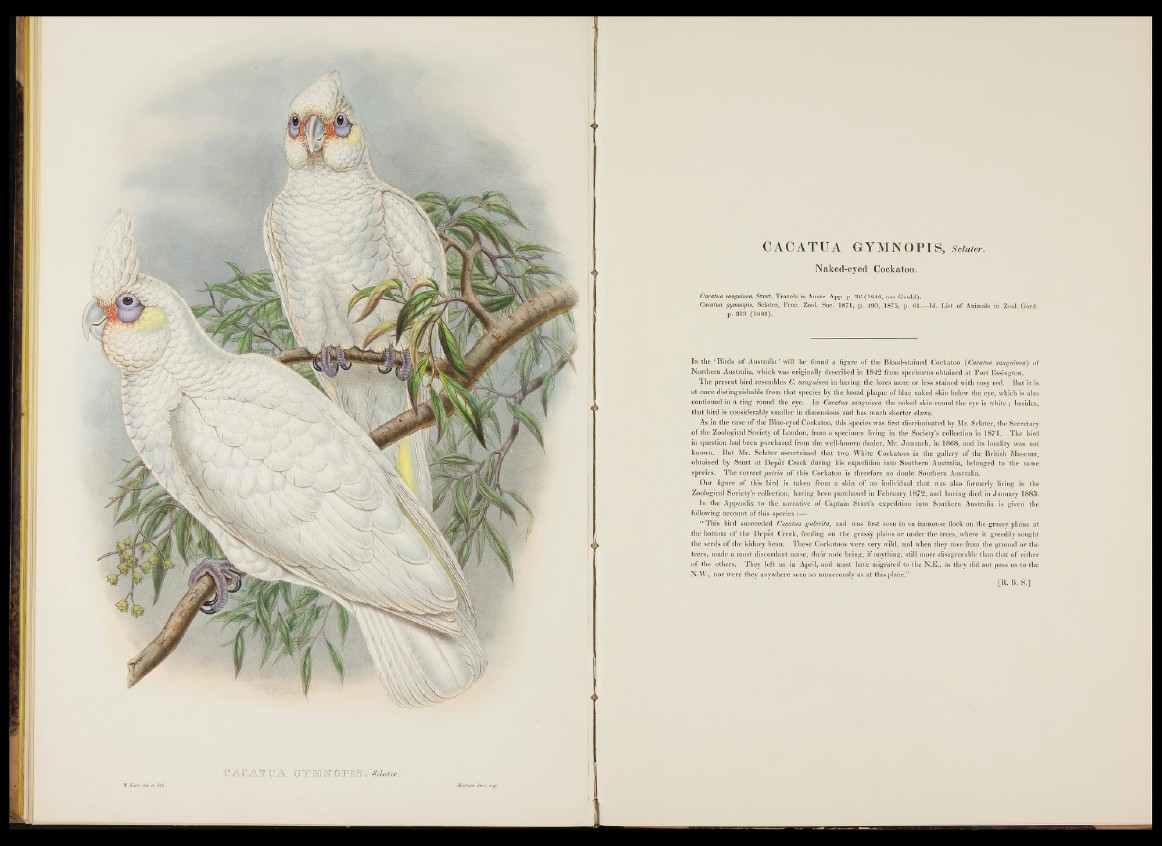
C A C À I U A 6 Y l L H ® M S i Sciata'.
CACATUA GYMNOPIS, Scla/er.
Naked-eyed Cockatoo.
Cacatua sanguinea, Sturt, Travels in Austr. App. p. 36 (1849, nec Gould).
Cacatua gymnopis, Sclater, Proc. Zool. Soc. 1871, p. 490, 1875, p. 61.—Id. List of Animals in Zòol. Gard.
p. 313 (1883).
In the ‘ Birds o f Australia* will be found a figure o f the Blood-stained Cockatoo (Cacatua sanguined) of
Northern Australia, which was originally described in 1842 from specimens obtained a t P o rt Essington.
The present bird resembles C. sanguinea in having the lores more or less stained with rosy red. But it is
a t once distinguishable from th at species by the broad plaque o f blue naked skin below the eye, which is also
continued in a ring round the eye. In Cacatua sanguinea the naked skin round the eye is white ; besides,
th at bird is considerably smaller in dimensions and has much shorter claws.
As in the case o f the Blue-eyed Cockatoo, this species was first discriminated by Mr. Sclater, the Secretary
o f the Zoological Society o f London, from a specimen living in the Society’s collection in 1871. The bird
in question had been purchased from the well-known dealer, Mr. Jamrach, in 1868, and its locality was not
known. But M |||S c la te r ascertained that two White Cockatoos in the gallery o f the British Museum,
obtained by S tu rt a t Depot Creek during his expedition into Southern Australia, belonged to the same
species. T h e correct patria o f this Cockatoo is therefore no doubt Southern Australia.
Our figure o f this bird is taken from a skin o f an individual th at was also formerly living in the
Zoological Society’s collection, having been purchased in February 1872, and having died in January 1883.
In the Appendix to the narrative o f Captain Stu rt’s expedition into Southern Australia is given the
following account o f this species :—
“ This bird succeeded Cacatua galerita, and was first seen in an immense flock on the grassy plains at
the bottom o f the Depot Creek, feeding on the grassy plains or under the trees, where it greedily sought
the seeds o f the kidney bean. These Cockatoos were very wild, and when they rose from the ground o r the
trees, made a most discordant noise, their note being, if anything, still more disagreeable than th at o f either
o f the others. They left us in April, and must have migrated to the N.E., as they did not pass us to the
N.W., nor were they anywhere seen so numerously as at this place.”
[R. B. S.]